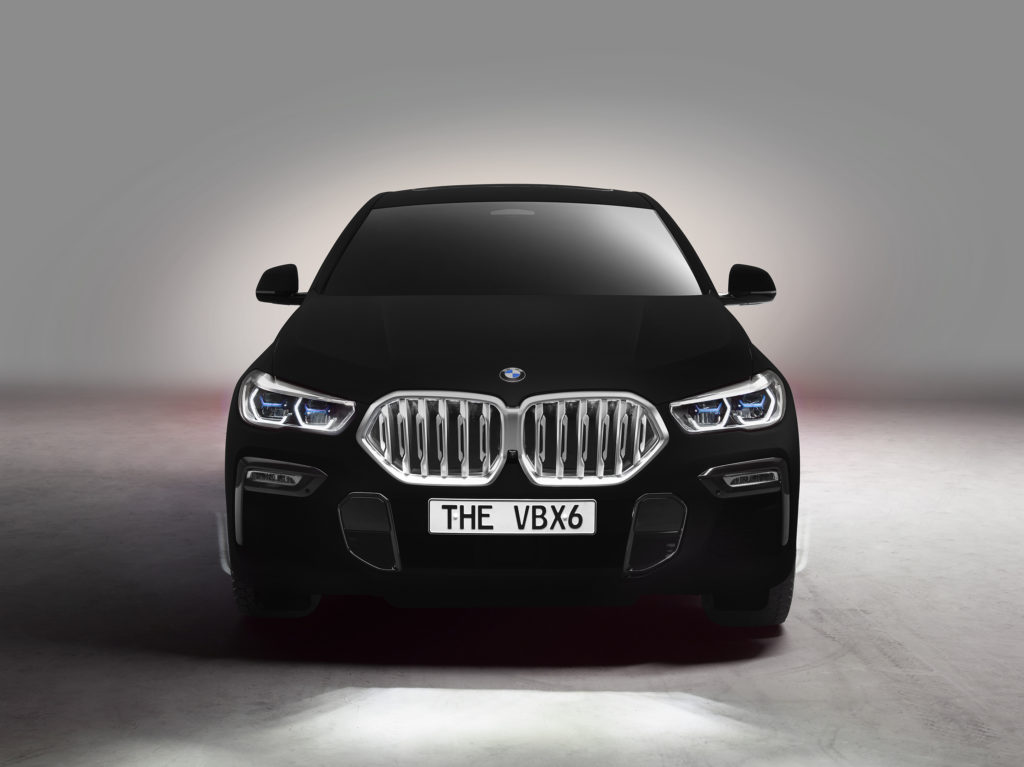Into the murdered-out look? People have been blacking-out their BMWs and other big-body European cars since the 1980s, but now the all-new third-generation X6 has been given a treatment that essentially puts all other efforts to shame. Finished in a specially-formulated coat of Vantablack paint, the VB X6, as its being called, loses almost all dimensional character, and takes the form of a deep void in photos that could easily be mistaken for computer-generated renders.
Brought to market in 2014 for specialized aerospace applications, Vantablack is, “the world’s blackest black,” according to its manufacturer Surrey NanoSystems. The first version, which is considered unusable for automotive applications, is said to absorb up to 99.965% of light, thanks to an innovative substructure of carbon nanotubes which are approximately 5,000 times thinner than a strand of human hair. When light strikes a surface covered in the material, instead of a reflective property or matte texture being lit up, the energy is absorbed and converted into heat. The nanotubes have a length that varies between fourteen and 50 nanometers, while the diameter is set at twenty, which means approximately one billion of the vertically-aligned carbon tubes fill just one square centimeter of area.
The G06 VB X6 is set to be unveiled at the Frankfurt Motor Show in September, but don’t expect the neat finish to be available on the BMW Configurator any time soon. A special formula had to be developed for automotive use, which is referred to as VBx2. Founder of Surrey NanoSystems and inventory of Vantablack Ben Jensen says other large automakers have approached the company numerous times over the years, but it wasn’t until the development of VBx2 and BMW inquiring about painting an X6 in the material that the idea was even considered. Jensen goes on to explain that the striking lines and undeniable presence of the X6, the model that ushered in the Sports Activity Coupe a decade ago, were instant qualifiers for the new generation, and that it just seemed like, “a really good fit.”
It’s said that the human eye perceives Vantablack as two-dimensional in appearance, something that is demonstrated by the various photos and in the video at the bottom of this article. VBx2, the unique formula applied to the X6, is slightly different from the original in that it can be sprayed onto surfaces, and that it offers a 1% total hemispherical reflectance. In other words, while VBx2 isn’t as black as other versions of Vantablack, it is nonetheless considered, “super black,” and has just enough of a reflective quality that the shape of an object is not completely lost.
Looking at the VB X6 though, it’s difficult to discern any defining angles or creases in the bodywork. Whether finished in a matte (or frozen) paint, or a traditional clear coat color, specific edges and folds in the various body panels interact with light that falls upon the sheet metal, creating shapes and design that appear familiar and recognizable to us. With Vantablack replacing a conventional finish, these characterizing elements essentially vanish. No matter the vantage point, the VB X6 looks like a black hole of sorts, actively sucking in particles and bodies of substantial mass that happen to get caught up in its pull.
Beyond the issue of Vantablack working by converting light into heat, which essentially negates any volume automotive use, there are also the struggles of adapting it for production in terms of durability that can stand up to a lifetime of daily use that remain to be overcome. Additionally, there are safety concerns about a color that would make anything it is applied to almost indistinguishable at night, save for lights and indicators.
Vantablack does serve an actual purpose though, as its primary function is that of a coating or finish for optical instruments and laser-based sensors, where the intrusion of stray light can taint signals. The idea is to create surfaces that simply do not reflect, so that only the light of distant stars and their solar systems is picked up by cameras aimed at deep space, for example, with no other light pollution influencing things.
Practical challenges aside, the VB X6 is a neat project for BMW to have embarked on, and the results are particularly captivating. Just a few defining characteristics stand out from the darkness of the SAC, the most striking of which are the illuminated kidney grilles and headlights themselves. We hope to see this one making the rounds at other auto shows after Frankfurt, in hopes of catching a glimpse of what doesn’t seem real on a computer screen, in the flesh.—Alex Tock
[Photos and video courtesy BMW AG.]
